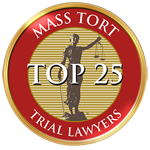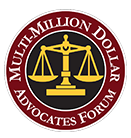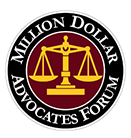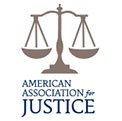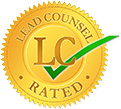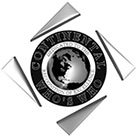Stern Law Litigating C-QUR™ Hernia Mesh Cases
If you underwent surgery to repair a hernia using surgical mesh and have developed postoperative injuries, you might have a claim for damages against the mesh manufacturer. Cases involving C-QUR™ hernia mesh are particularly active right now, as evidence mounts against the manufacturer of those implants. If you believe you have a C-QUR™ implant, contact our office today. The attorneys at Stern Law, PLLC, can help you understand your rights and determine whether you can file a lawsuit.
Hernia Causes and Treatment
A hernia is the bulging of internal organs through the wall of muscle or tissue that ordinarily contains them. Hernias are often caused by episodes of lifting heavy objects, chronic coughing, enduring pregnancy and childbirth, being overweight, or straining because of constipation. Certain activities or conditions — preexisting muscle conditions, aging, continual strain on the abdomen or groin — can increase a person’s likelihood of developing a hernia, and gender can also play a role. For instance, men are far more likely than women to develop hernias in the groin area.
The most commonly known hernias are:
- Umbilical hernias (occurring near the belly button)
- Ventral hernias (occurring in the abdominal wall)
- Inguinal hernias (occurring in the groin area)
- Femoral hernias (occurring in the inner thigh area)
- Hiatal hernias (occurring in the chest and diaphragm area)
- Epigastric hernias (occurring between the chest and belly button)
- Incisional hernias (occurring at the site of a previous surgical incision)
The standard treatment for a hernia is an operation to push the herniated tissue back in place and create a stronger muscle wall to prevent the hernia from coming back. Surgeons generally use one of two methods to perform these surgeries:
- Open surgery – Open surgery involves a long incision around the hernia site. The surgeon will open up the skin and fat and create a hole in the muscle down to the hernia, then push the herniated tissue back in place and reinforce the muscle/tissue wall. All types of hernias – big and small – regardless of location can be repaired using this method.
- Laparoscopic surgery – Laparoscopic surgery is often regarded as a less invasive option that involves a smaller incision. The surgeon will place a balloon or gas into the body through the small incision, which will expand to create room for the surgeon to work. The surgeon will then repair the hernia using a camera and surgical tools to pull the hernia back and reinforce the muscle/tissue. Smaller hernias are usually best suited for repair using this technique.
What is C-QUR™ Mesh?
C-QUR™ is the name of a line of a polypropylene monofilament mesh products manufactured by Atrium Medical Corporation, a subsidiary of Maquet Getinge Group. The C-QUR™ products are designed for both open and laparoscopic repair of hernias but can also be used for chest wall reconstruction or wound repair. The signature aspect of the C-QUR™ implants is their incorporation of a gel coating containing Omega 3 fatty acids. This Omega 3 coating supposedly is biocompatible and minimizes tissue attachment to the mesh, according to Atrium.
There are several products in the C-QUR™ line:
- C-QUR™ Mesh – This is the original C-QUR™ product and can be ordered in various shapes and sizes, depending on the size and location of the hernia.
- C-QUR Mosaic™ – An extension of C-QUR™ mesh, containing 25 percent less Omega 3 coating than the first generation of C-QUR™ products. This comes in a flat sheet to be sized appropriately by the patient’s surgeon.
- C-QUR Tacshield™ – Another extension of C-QUR™ mesh, indicated for open repair of larger ventral hernias. This mesh comes in various sizes and shapes, again depending on the particular hernia.
- C-QUR V-Patch™ – Another C-QUR™ implant, indicated for repair of ventral hernias. It comes in a round patch and allegedly has “advanced deployment technology.”
- C-QUR Centrifix™ – Another C-QUR™ product, indicated for laparoscopic repair of inguinal hernias. It comes in three sizes, depending on the size of the hernia, and can be ordered to fit the right or left side of the groin.
- C-QUR FX Mesh™ – The last of the current C-QUR™ line, containing a “light spray” of Omega 3 coating and indicated for both open and laparoscopic repair of hernias. This mesh also comes in various shapes and sizes for surgeons to select.
Atrium’s biggest selling point for this line of mesh is the Omega 3 coating, but this coating can cause serious injury to patients implanted with C-QUR™ mesh. These injuries include a severe rash or allergic reaction. The implants also lead to a host of other complications.
C-QUR™ Mesh Injuries
With our extensive experience in mesh litigation at Stern Law, we have unfortunately heard about a significant number of C-QUR™ injuries from our clients. Complications from C-QUR™ mesh can greatly interfere with quality of life and result in continuous need for medical treatment and repeated surgeries.
Numerous patients who have undergone surgery to repair a hernia using C-QUR™ mesh experience subsequent problems related to the implant. The polypropylene used to make C-QUR™ products is essentially plastic, the same kind used for carpet backing. When that mesh is introduced into delicate human tissue, the patient has an immediate reaction, known as a foreign body response. This response triggers pain and inflammation that can become chronic. The patient’s body understands something abnormal has been placed in the body, and it attempts to close off the implant from the rest of the body by encasing it in scar tissue and sending out a strong immune response.
Other C-QUR™ injuries can range from ongoing infection to major medical complications requiring extensive additional surgeries. The most common injuries from C-QUR™ hernia mesh implants we have seen in our practice include:
- Chronic pain (both localized and radiating to the limbs)
- Infection (minor or ongoing requiring surgery)
- Adhesions (thick formation of scar tissue that adheres to healthy tissue or organs)
- Bowel Obstruction (blockage of the large or small intestine)
- Rejection of the mesh (intense foreign body reaction)
- Allergic reactions (rash from the Omega 3 coating)
- Mesh tearing (ripping, fraying, unraveling of the implant)
- Mesh erosion and perforation (degrading of mesh or mesh puncture into nearby organs)
- Mesh folding (rolling or rippling after implantation)
- Mesh migration (movement from correct placement)
- Mesh shrinkage (contraction of mesh)
Several injuries that can develop from implantation of C-QUR™ mesh require surgery to remove the original mesh and readdress the existing hernia. Unfortunately, due to the design of the mesh material, removal is extremely difficult and sometimes impossible.
The porous nature of hernia mesh encourages rapid tissue embedment, which makes dissection and removal tedious and complicated. Atrium claims the Omega 3 coating in its C-QUR™ implants minimizes tissue attachment to the mesh, but in reality, the tissue ingrowth process is still a major issue for C-QUR™ patients. The process starts immediately and can be complete in about 30 days, making it difficult for doctors to timely intervene and safely separate the mesh from the patient’s tissue. In some cases, the mesh can never be fully removed.
FDA Information Regarding C-QUR™ Mesh
The Food and Drug Administration (FDA) has a system whereby patients, doctors, and manufacturers can report problems with drug or medical device products. These reports are called “adverse event reports.” Since patients started receiving C-QUR™ mesh implants in huge numbers, the FDA has received a continuous large volume of adverse event reports related to the mesh. Some of the individual accounts include:
- In April 2016, a surgeon reported that his patient had a skin reaction to C-QUR™ mesh implanted for hernia repair. Eight months following surgery, the patient developed a rash at the edge of the mesh implant.
- Also in April 2016, a patient reported undergoing surgery for hernia repair using C-QUR™ mesh, stating that the mesh had to later be removed because it was infected. The patient’s doctor noted that the infection was located at the two port entries and behind the muscle in front of the mesh.
- In January 2016, a patient reported receiving a C-QUR™ implant for hernia repair. Following surgery, the patient came back to the hospital with pain. Upon examination, the patient’s doctor discovered puss surrounding the mesh implant. The infected mesh was removed during a subsequent operation. The doctor reported it was very unlikely the mesh had become contaminated prior to implantation but rather had become infected after implantation in the patient.
- Also in January 2016, a patient reported having C-QUR™ mesh inserted in the abdominal area. The Omega 3 onlay barrier caused a reaction. A clot formed, the skin changed color, and the patient had to undergo an additional surgery to remove the mesh. The patient reported having a 10-inch scar on the patient’s stomach and a loss of seven weeks’ pay from missed work.
- Also in January 2016, a patient reported that the patient’s body has rejected a C-QUR™ mesh implant approximately one year after implantation. The patient required surgery to remove the C-QUR™ mesh.
These are merely a few of the reports received as to the C-QUR™ mesh line in 2016. While the FDA is well aware of the potential for serious health risks, it has taken little to no action regarding C-QUR™ mesh.
In August 2009, the FDA published a statement in which it reported that Atrium had issued recall letters for its C-QUR Edge™ and C-QUR V-Patch™. In the recall, Atrium reported that when these mesh implants were exposed to excessive humidity for an extended period of time, the increased humidity inside the pouch packaging could potentially cause the coating on the mesh to strongly adhere to the inner handling sleeve. However, despite the recall, neither Atrium nor the FDA ever removed C-QUR Edge™ or C-QUR V-Patch™ products from the market. Limited information currently exists regarding the C-QUR Edge™, though, suggesting it might have been silently withdrawn from the market.
Outside of disseminating Atrium’s own content, the FDA has been relatively silent as to the safety concerns of C-QUR™ mesh implants. In April 2017, the FDA issued a general statement widely addressing hernia mesh. It reported on the most common adverse events following hernia repair with mesh. The FDA stated pain, infection, hernia recurrence, adhesion, and bowel obstruction were the most common complications associated with hernia mesh. But it also minimized these injuries by noting that the same complications occur with all mesh surgeries, with or without use of mesh.
In the same statement, the FDA went on to say it had received many reports of complications related to hernia mesh, but that the Administrations had concluded recalled mesh products were the main cause of several of these complications. Our attorneys find this bewildering because our clients continue to report debilitating injuries from C-QUR™ mesh products readily on the market. Where you cannot rely on the FDA to take strong action, we will. Stern Law can help you hold Atrium accountable for your injuries.
C-QUR™ Marketing to Doctors
As a patient, you want to be able to trust that your doctor would never give you a dangerous implant. So how is it that your doctor used this unsafe C-QUR™ mesh? It might surprise you to know that the vast majority of information doctors receive about medical devices comes straight from the manufacturers – the corporations trying to sell the devices. And when making sales, manufacturers tend to leave out the ugly truth.
Manufacturers fund and control their own hernia mesh studies or, alternatively, conduct zero clinical trials and rely on the 510(k) clearance process to get their products in doctors’ hands. It is important to note there is a major distinction between FDA approval and FDA clearance. A product gaining clearance does not have the approval of the FDA. The paltry studies manufacturer’s conduct for clearance have skewed data because of limited observation time and the obvious differences between the ways devices behave in humans as opposed to rats.
With favorable study in tow, manufacturers then send representatives to give presentations to doctors, train doctors, and even participate in patient surgeries to show doctors how to use the mesh implants. Doctors are met with an intense level of pressure to buy, and they do not have all the information.
In example, in 2016, a major Atrium competitor in the hernia mesh arena pulled one of its most popular hernia mesh options from the market (Ethicon Physiomesh). As soon as this occurred, Atrium started sending letters to doctors offering C-QUR™ mesh as an alternative to fill their hernia repair needs. It is this kind of aggressive marketing that makes doctors likely to use one product over another and leaves patients vulnerable to the consequences.
In our hernia mesh lawsuits, Stern Law alleges that manufacturers, including Atrium, failed to properly warn doctors of all the risks associated with their mesh and failed to properly train doctors as to how to implant the mesh.
C-QUR™ Litigation News
In litigations the size of hernia mesh, where numerous manufacturers and products are involved, the parties will usually try to form Multidistrict Litigations (MDLs). An MDL is a consolidation of cases in one federal court to ensure uniformity of decision. Unique MDLs can be formed for each manufacturer, based on the number of lawsuits filed against that manufacturer. The MDL court will then oversee all pretrial matters, including hearings and discovery, as well as the first trials. With an MDL, plaintiffs and defendants do not have to try to make sense of hundreds of different court decisions, but rather adhere to the rulings of one court.
Most recently, an MDL formed to centralize hernia mesh lawsuits filed against Atrium Medical Corp. in the U.S. District Court of New Hampshire. This MDL includes all the C-QUR™ mesh products. The Honorable Landya B. McCafferty presides over this MDL and will soon begin setting orders for how the litigation against Atrium will proceed.
Do I Have a Claim?
If you or a loved one had hernia repair surgery using mesh and developed a postoperative injury, contact Stern Law, PLLC, today to talk to one of our attorneys. During your call, you will be able to schedule a free consultation with a seasoned product liability lawyer, who will explain the litigation process and the services we provide. When you hire our firm, your attorney will prepare your case by:
- Obtaining a detailed account of your surgeries and injuries;
- Ordering medical records for your original hernia operation, as well as any further treatment or surgery;
- Determining product identification, or the name of your exact mesh implant, as well as the name of the manufacturer;
- Consulting with medical experts and industry experts to obtain support for your claim;
- Determining where your case should be filed and against whom;
- Drafting and preparing a petition for filing.
Note that one of the things we will do for you is obtain the name of your mesh implant and identify who manufactured it. The majority of the time, our hernia mesh clients do not know what kind of mesh implant they have and are worried they might not be able to move forward. We understand surgeons do not often share product names with patients, so this is not something you need to be concerned about. We will order your medical records to prove which implant you have, and we will do everything we can to build a successful claim on your behalf.
Stern Law Offering Free C-QUR™ Claim Review
When you are trying to hire a lawyer for a product liability lawsuit, it can be difficult to know where to begin, but at Stern Law, we make the process as stress-free as possible. In your first call to our firm, you’ll be able to schedule a consultation with one of our skilled surgical mesh attorneys, who will listen to your story and help you understand your options.
We know our clients have already endured costly treatment and revision surgeries because of their C-QUR™ mesh injuries, and they are struggling under the weight of costly medical bills. That’s one of the reasons we offer free case consultations. Your initial call or meeting with our firm is completely free, and we will investigate your claim without ever asking for money up front. If our investigation concludes we cannot pursue a claim for you, you never have to worry about receiving a bill from us.
Additionally, if we conclude we can pursue a claim on your behalf, we will generally advance the costs of doing so. Most people cannot afford the expenses associated with litigating a product lawsuit, so we assume that financial risk for you and contract our cases on a contingency fee basis. That means we only get paid if you get paid. If you do not receive a money award from your lawsuit, you will not owe us anything.
Especially in the circumstances of C-QUR™ mesh, when you are potentially filing a claim against a major medical corporation, the process can seem intimidating. But when you hire Stern Law, you can rest easy knowing we have the resources and experience to bring you the justice you deserve. We take on the biggest corporations and don’t shy away from complex cases because we firmly believe in the justice of holding medical device manufacturers accountable. Together, we can make the industry safer for people in the future and secure the compensation you deserve.
Contact Stern Law, PLLC
At Stern Law, PLLC, we know how your medical device injuries have affected your life. Our legal team has the knowledge and skills you need on your side during this stressful time. Our experienced attorneys can achieve the just result you deserve, starting with a confidential consultation at no cost to you. Contact our office today by calling (844) 808-7529, and schedule your free consultation with one of our compassionate product liability attorneys

